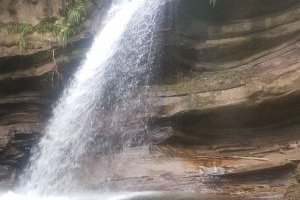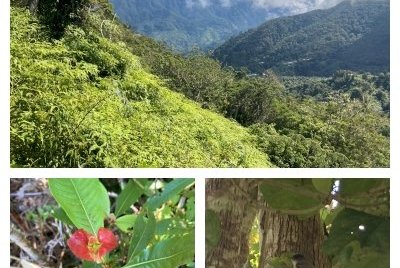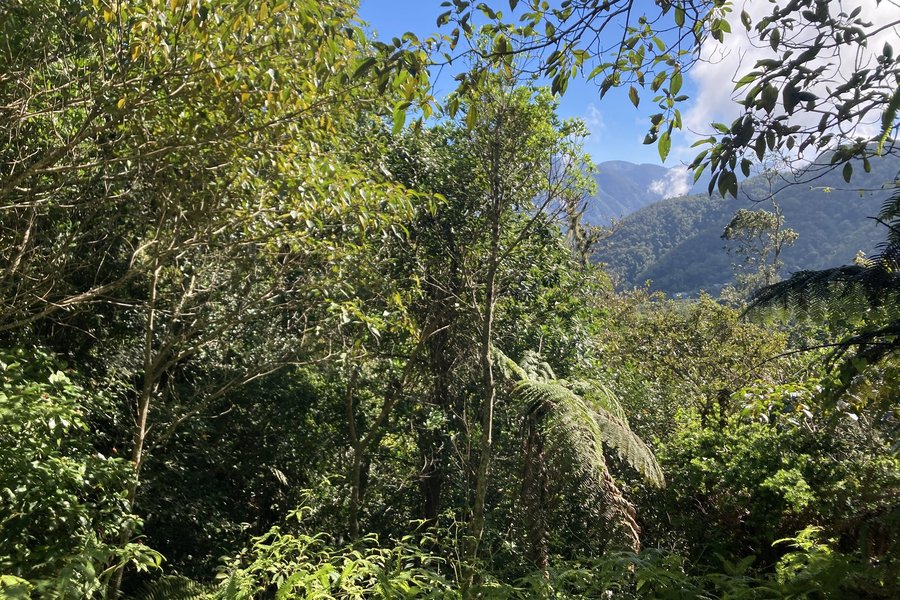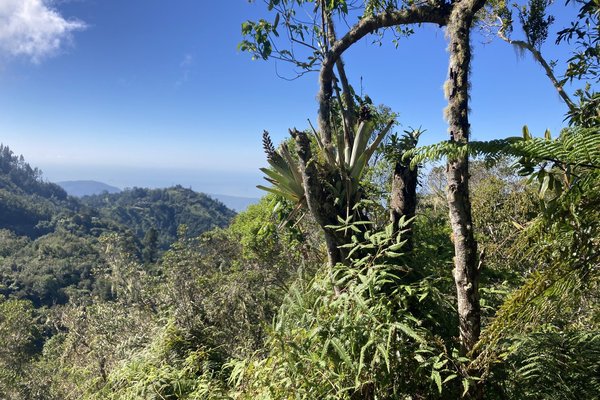Jamaica
Blue and John Crow Mountains
The Blue and John Crow Mountains are a remote mountainous region known for its biodiversity and relevance to the history of Jamaican Maroons.
The region provided refuge to escaped indigenous slaves, the traces of which can be seen at Maroon archaeological sites, such as hiding places and a network of trails. They lived in and around the settlement of Nanny Town. The area is limited to the Preservation Zone of the Blue Mountains and John Crow Mountains NP. These mountain ranges are covered with dense tropical and montane rainforest. A wide variety of endangered and/or endemic plant, frog and bird species is found here.
Community Perspective: the Blue Mountains and its coffee history are well on the Jamaican tourist trail, but visiting the rather limited core zone of old forest is another cup of tea. Els has described the options for a rewarding visit, while Jacob went all the way to Moore Town.
Site Info
Official Information
- Full Name
- Blue and John Crow Mountains (ID: 1356)
- Country
- Jamaica
- Status
-
Inscribed 2015
Site history
History of Blue and John Crow Mountains
- 2015: Name change
- TWHS was called "Blue and John Crow Mountains National Park", but large parts of national park were moved to buffer zone during final nomination stages
- 2015: Inscribed
- Inscribed
- 2011: Deferred
- Type
- Mixed
- Criteria
- iii
- vi
- x
Links
- UNESCO
- whc.unesco.org
- Official
-
- blueandjohncrowmountains.org — Blue and John Crow Mountains National Park
- Related
-
- academia.edu — The Nanny Town Maroons of Jamaica
- sgp.undp.org — Tourism Assessment Report Rio Grande Valley
All Links
UNESCO.org
- whc.unesco.org — whc.unesco.org/
Official Website
- blueandjohncrowmountains.org — Blue and John Crow Mountains National Park
Related Resources
- academia.edu — The Nanny Town Maroons of Jamaica
- sgp.undp.org — Tourism Assessment Report Rio Grande Valley
News Article
- Dec. 5, 2015 jis.gov.jm — Another Maroon Site Identified In Blue and John Crow Mountains
- Dec. 3, 2015 jamaicaobserver.com — Fine of up to $50,000 for committing various offences in the Blue and John Crow Mountains
Community Information
- Community Category
- Natural landscape: Forest
- Archaeological site: Caribbean
Travel Information
Recent Connections
-
Centres of Plant Diversity
Cb10 Blue and John Crow Mountains - "On… -
Queens and Empresses
Queen Nanny - "associated with Maroon … -
Foreigner prices
The Holywell Recreation Area and Blue M…
Connections of Blue and John Crow Mountains
- Geography
-
-
Situated in one of the SIDS
Jamaica
-
- Trivia
-
-
Minority communities
Jamaican MaroonsSee en.wikipedia.org
-
Blue Mountains
Blue Mountains, named for the mist that gives the mountain the outstanding blue shadeSee en.wikipedia.org
-
- History
-
-
Queens and Empresses
Queen Nanny - "associated with Maroon oral tradition about Queen Nanny and the Maroons." (AB ev) and "Queen Nanny, Granny Nanny, or Nanny of the Maroons ONH (c. 1686 – c. 1760), was an 18th-century leader of the Jamaican Maroons." (wiki)See en.wikipedia.org
-
- Ecology
-
-
Cloud forest
"Supplementary information provided by the State Party notes that the nominated property consists of tropical, montane rainforest, much of which is cloud forest between 850m and 2,256m." and "Above 2,000m the forest is known as Elfin Forest due to the stunted and gnarled appearance of the trees which are heavily coated with epiphytes including hanging mosses, ferns and tiny orchids." (IUCN ev) -
Turtles and tortoises
1 turtle species (AB ev)
-
Orchids
"Above 2,000m the forest is known as Elfin Forest due to the stunted and gnarled appearance of the trees which are heavily coated with epiphytes including hanging mosses, ferns and tiny orchids." (OUV) -
Rainforests
"Supplementary information provided by the State Party notes that the nominated property consists of tropical, montane rainforest, much of which is cloud forest between 850m and 2,256m." (IUCN ev) -
Bird Migrations
The Americas Flyway -
Endemic Bird Species
101 birds (32 endemics) -
Critically endangered fauna species
Arntully Robber Frog (1-249 mature individuals remaining) - possibly extinct
-
- World Heritage Process
-
-
First inscriptions
Jamaica 2015 -
Slow Starters
1983 - 2015 (32 years) -
Natural sites filling gaps cited by IUCN
The BJCM has also been identified as a gap in representation of World Heritage sites: it belongs to a Centre of Plant Diversity and an Udvardy biogeographic province not yet represented on the List and as noted above it overlaps with one of 78 most irreplaceable protected areas in the world (AB ev)
-
- Religion and Belief
-
-
Sacred Mountains
"The mountains in themselves are held sacred by the Maroons, firstly because they are the burial ground of their ancestors and, according to West African belief, their spirits live close to these sites" (AB ev) -
Living indigenous religions
Obeah, strongly connected to Nanny of the Maroons
-
- Human Activity
-
-
Maroonage
The region provided refuge to escaped indigenous slaves, the traces of which can be seen at Maroon archaeological sites such as hiding-places and a network of trails. The ‘Windward Maroons’ of the Blue Mountains region were one of two Maroon strongholds in Jamaica. -
Secret Locations
Nanny Town Cultural Heritage Route .. secret trails, settlements and natural resources
-
- WHS on Other Lists
-
-
Alliance for Zero Extinction
The BJCM contains two of Jamaica’s five Alliance for Zero Extinction sites (AB ev): Jamaican Peak Frog and Jamaica Petrel -
UNESCO Intangible Cultural Heritage Lists
The Maroon Heritage of Moore Town was listed in 2003 as a Masterpiece of the Oral and Intangible Heritage of Humanity and then relisted in 2008 on the Representative List of Intangible Cultural Heritage of Humanity. (AB ev) -
Centres of Plant Diversity
Cb10 Blue and John Crow Mountains - "One of two Centres of Plant Diversity in Jamaica, the property includes a reported 1,357 species of flowering plant of which approximately 294 are Jamaican endemics and 87 of these species are found only within the property." -
Biodiversity hotspot
Caribbean Islands
-
- Timeline
-
-
Late Pleistocene
Fauna seems to date from late Pleistocene -
Built in the 17th century
apparently before the arrival of the British in 1655, that the Maroons moved away from the Nueva Sevilla area to the north-eastern region of the Island (AB ev)
-
- Visiting conditions
-
-
No road access
The closest access is walking about 1km from the Moore Town roadhead to Nanny Falls. Plus there is a tiny road that extends just south of Bowden Penn, which is technically part of the core zone. -
Foreigner prices
The Holywell Recreation Area and Blue Mountain Peak hike require 10USD and 20USD respectively, while locals pay 300 and 400 Jamaican dollar (2-2.5 USD).
-
- WHS Names
-
-
Name changes
from Blue and Jhon Crow Mountains NP to Blue and John Crow Mountains to reflect removal of large parts of the NP to the buffer zone -
Named after a Mountain
"The Blue Mountains are the longest mountain range in Jamaica. They include the island's highest point, Blue Mountain Peak, at 2256 m (7402 ft)" . The John Crow Mountains. "extend parallel with the northeast coast of the island, bounded to the west by the banks of the Rio Grande, and joining with the eastern end of the Blue Mountains in the southeast, The highest point in the range is a little over 3,750 feet (1,140 m)"
-
- Literature & Film
-
-
James Bond in Movies
The Blue Mountains appear in the first James Bond movie Dr No -
Featured in the Go Jetters
Series 1: Episode 49: Blue Mountains, Jamaica
-
News
- jis.gov.jm 12/05/2015
- Another Maroon Site Identified In …
- jamaicaobserver.com 12/03/2015
- Fine of up to $50,000 for committi…
Recent Visitors
Visitors of Blue and John Crow Mountains
- Ali Zingstra
- AndreaTLV
- Bauchat
- Bram de Bruin
- Can SARICA
- Cheryl
- Chinmaya
- Daniel Gabi
- dave wood
- Dennis Nicklaus
- Els Slots
- Eva Kisgyorgy
- Felicité
- GerhardM
- Gernot
- Gjert
- Harald T.
- hegeline@icloud.com
- Iain Jackson
- Jacob Choi
- Janos
- Jawnbeary
- Kasper
- KeithBailey
- Kelly Rogers
- Loic Pedras
- Luis Filipe Gaspar
- Mikko
- pghgeekgrrl
- Philipp Leu
- Pink Bunny
- Roger Ourset
- Roman Bruehwiler
- sbshipway
- Solivagant
- Thomas Buechler
- Thomas van der Walt
- Tschibi
- Vanessa Buechler
- Wo_ko
- Zoë Sheng
Community Reviews
Show full reviews
For a long time, there has been some discussion on how to visit the "Core Zone" of this site properly. The maps on the UNESCO website certainly don't help and many who go to Jamaica on holiday don't go hiking through the Blue Mountains. This made getting information on how to get into the core zone a bit more difficult than anticipated. Luckily for me, Els wrote a nice review below that did most of the grunt work. With that in mind, I was able to focus in on Moore Town. However, multiple tour operators were not able to provide tours to the falls. So, with a little more searching, I was able to find Alex Moore-Minott (+1 876 495 7370) through the Granny Nanny Cultural Center, who was eager to take me to the falls and teach me about the culture of the Jamaican Maroons. The problem though, was getting there!
Through a driver in Jamaica we settled on leaving Kingston at 7 AM. Winding up and down through the mountains via narrow and twisty roads was somewhat slower than I thought. Eventually we reached the coast to drive to Port Antonio and then back into the mountains to reach a jungle valley that Moore Town is situated. Make sure to download any maps before hand as you will lose signal on the way there! The villagers rope off any outsider vehicles and I had to check into the cultural center and wait for my guide. In the …
Keep reading 0 comments
68 people so far claim to have visited this WHS, but this has resulted in only one generic review and a (since replaced) funny main site photo of a marker essentially saying “You’re in the National Park but not in the WHS core zone”.
It’s hard to visit Jamaica and not ‘see’ the Blue Mountains in some way, but is that enough to ‘tick’ this site? Let me share what is possible to visit and what you should look out for.
The OUV
The OUV of both the cultural and natural side of this mixed WHS lies in the rugged, inaccessible terrain. The maroons used it to hide away from colonial oppression, while the island’s native flora managed to survive here while much of the rest of the island was cultivated. These two features don’t mix well, which becomes clear on the official map (best seen in map #4 of the nomination dossier): the descendants of the maroons live in villages that are clearly not in pristine nature and so they’re mostly outside of the National Park (they're considered ‘satellite sites’ by ICOMOS). And what Jamaica deems worthy enough of National Park status wasn't good enough for IUCN, who managed to scope the core zone of the WHS down to primary forest only.
Oh – and when you think this WHS is about coffee you just lost your ‘tick’ as IUCN strongly condemned “encroachment from coffee farming”.
Places to visit
Moore Town would be the place to start for a …
Keep reading 0 comments
We visited Blue and Crow Mountains in November 2017. We hired a driver to take us from Port Antonio and we are very glad that we did. Some of the roads were not in great shape and we got to gape at the stunning scenery. We were told that the "good road" will be completed all the way to the northern part of the island eventually. It was complete from Kingston to the National Park when we went. This would be the only part I would be willing to drive if I had a rental.
We stayed in a guest house for a few days. We hiked on marked trails and on one day we went on one of the ubiquitous and obligatory "hidden waterfall" hikes. Our guide made the history of the site come alive for us by pointing out the uses of all of the plants we encountered. We could understand how the Maroons could live in the jungle and have everything they needed. We did not hike to the summit of Blue Mountain, which requires getting up before sunrise to avoid the characteristic mists, because everyone we met that tried, climbed into a cloud (so no views).
We visited a small coffee plantation and it was delicious! Believe the hype! The coffee is good.
The people that live in Blue Mountains are friendly, opinionated and hospitable. My favorite combination. We enjoyed our visit very much and would recommend that anyone visiting Jamaica spend some …
Keep reading 0 comments
